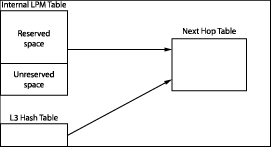The extended IPv4 host cache feature relates to the four hardware forwarding tables shown in Hardware Forwarding Tables.

The Longest Prefix Match (LPM) and Layer 3 (L3) Hash tables store host and route information for fast-path forwarding. When the switch locates a route or host in one of these tables, it follows a table index to the Next Hop table, which contains MAC address and egress port information that is shared by the hosts and routes in the other tables. The hardware routing table capacity is partly determined by the capacity of the Next Hop table. The Next Hop table capacity is smaller than the combined capacity of the other tables because typically, multiple routes and hosts share each Next Hop table entry. When the other tables map to many different next hop entries, the Next Hop table can limit the total number of hosts and routes stored in hardware.
On most platforms, the L3 Hash table is smaller than the LPM tables. Because the L3 Hash table is the only table that can store IPv4 and IPv6 multicast entries and IPv6 local hosts, and because of the way the L3 Hash table is populated, forwarding table capacity and forwarding performance can be improved by allocating space for storing IPv4 local and remote host entries in the LPM tables.
The extended IPv4 host cache feature specifically allows you to define the number of entries that are reserved in the LPM tables for IPv4 and IPv6 routes. The unreserved entries are available for IPv4 local and remote hosts. IPv4 hosts can also occupy unused areas of the L3 Hash table, and when necessary, unused space in the reserved section of the LPM tables. The maximum number of hosts that can be stored in the hardware routing tables depends on the configuration and usage of the tables, but the number of local IPv4 hosts and gateways is ultimately limited to the size of the Next Hop table minus three reserved entries.

 Print
this page
Print
this page Email this topic
Email this topic Feedback
Feedback